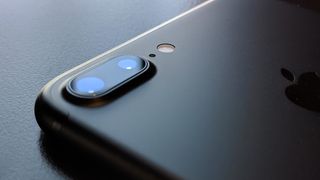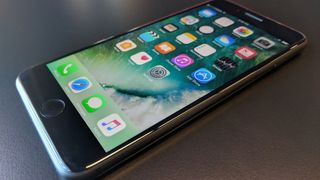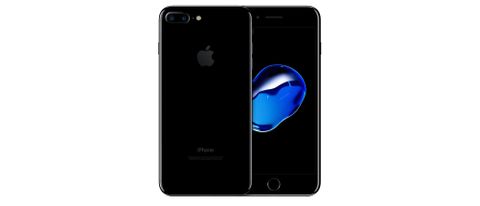The Apple iPhone 7 Plus didn’t exactly make waves when it launched back in 2016. Not that it wasn’t a great smartphone, it was a fantastic piece of kit - stylish, easy to use and filled with premium hardware. But it was a slightly disappointing entry into the iPhone legacy because it was more iterative than innovative. The iPhone 7 Plus was a safe entry, and while that was a little dull at the time, it’s aged like a fine wine if you’re looking for the best smartphones for seniors.
Some senior users out there don’t care for the latest technology, or how many megapixels the camera has - they just want a simple, easy to use smartphone that looks good, has a long battery life, and helps them stay in contact with their loved ones. On those fronts, the iPhone 7 Plus still ticks all the boxes, even if it’s outdated when compared to the best smartphones.
Apple no longer sells the iPhone 7 Plus, but you can still find it at some third party retailers, and refurbished/second hand models are plentiful. If you want something newer that does the same job, maybe check out the iPhone SE 2020.
But now let's get back to the iPhone 7 Plus and rundown all the features on this nifty little handset.

Apple iPhone 7 Plus review: Design
At a glance, the iPhone 7 Plus looks like an iPhone 6s Plus. It has the exact same 5.5-inch, 1080p display; the same wide bezels; and the same rounded edges. Visually, there are only three modifications you’re likely to notice: a newly available finish, rearranged antenna lines and the removal of the 3.5mm headphone jack.
The new jet black finish is drop dead gorgeous – at first. Polished to a mirror shine, the color has been likened to that of a grand piano, and it’s an apt comparison. The phone is inky, almost vibrantly black. It’s also extraordinarily prone to scratches and smudges, even under careful handling. Simply bumping it along the surface of a table is enough to scuff the finish, and the glossy coat reveals every fingerprint. If you buy jet black, you’ll definitely want to shield it inside a case.
On the plus side, the jet black finish does a phenomenal job of hiding the iPhone 7 Plus’ antenna lines. Antenna lines are something of a necessity in aluminum phones, since the radio signals used for calls and LTE connections can’t penetrate metal. In previous generations, Apple used plastic gaps in the metal chassis to let the signals through; in the iPhone 7 and 7 Plus, it wraps the antenna around the outer housing of the phone itself, just beneath the finish. The resulting lines are still quite visible in lighter color variants, but they’re harder to see against the matte black finish and almost imperceptible beneath the jet black coating.
Of course, the change most people are likely to notice has little to do with aesthetics and a lot to do with usability. Apple has done away with the 7 Plus’ headphone jack, opting instead to include earphones that connect through the charging port and an adapter that works with your current pair of 3.5mm headphones. Dropping the jack freed up space in the phone that, after some rearranging, went toward its improved cameras and larger battery.
The tradeoff may not have been worth it. Yes, analog headphones jacks are a dated technology, but they’re also cheap and ubiquitous. You can buy earbuds that will work on your smartphone just about anywhere. Now you’re forced to either make use of an additional dongle, buy new headphones that can connect via the Lightning port or go wireless – fun, but expensive and charged separately. No longer can you listen to music while charging your phone up. The iPhone 7 Plus came out before Apple started integrating rapid charging into its batteries, so it can take a while to refuel.

Apple iPhone 7 Plus review: Specs
For the first time in the iPhone’s history, the Apple iPhone 7 Plus boasted three built-in cameras: one front-facing camera with a 7MP sensor and two linked 12MP cameras on the back. The rear-facing cameras work in concert. One has a standard wide-angle lens, while the other uses a two-times-magnification zoom lens to get closer to subjects. The setup wasn’t particularly original – LG notably did the same thing with its G5 smartphone – but Apple’s customary polish is ever present. You can zoom with perfect smoothness from one- to 10-times magnification on the iPhone 7 Plus, and two-times-magnified photos are as crisp and clear as shots taken at one-times magnification.
Both rear-facing lenses boast optical image stabilization and f/1.8 apertures. The stabilization lets the camera keep its shutter open longer, while the bigger-than-average aperture lets in more light. The result is more data for Apple’s digital image processor to work with, and that processor is where the real magic happens.
On specs alone, Apple’s cameras aren’t remotely groundbreaking, but with the processor working furiously behind the scenes, the 7 Plus can deliver clearer, crisper photos with a wider color gamut than almost any other phone on the market. Especially on the device’s large screen, they look brilliant.

If the heart of a smartphone is its processor, then the iPhone 7 Plus has a beastly pump. Apple’s custom-designed A10 Fusion chip is faster than its predecessors in every way, and it shows in day-to-day use. There’s no part of the iOS 10 interface that isn’t fluid and snappy, nor a task that seems to take too long to complete. Yet the real benefit of the new processor isn’t its power so much as its lack of power draw.
The A10 Fusion chip has four processor cores. Two of these cores are high-intensity: They draw the usual amount of battery power and pump out tremendous performance. The other two cores are tuned for low-impact tasks. They’re still powerful in their own right, but they’re far more energy-efficient. If you’re only browsing the web or checking your email, you’ll draw a lot less battery life than you would if you were plowing through an intense 3D game. A dedicated onboard system dynamically switches between the four cores, constantly optimizing battery usage.
Of course, when it needs to pump out the pixels, the Fusion chip can more than manage. We run every smartphone we review through an onslaught of synthetic and real-world benchmarks, and the results here were staggering; the A10 Fusion set the new high bar for performance, managing an average score of 36,711 in 3DMark’s Ice Storm Unlimited test and an average of 5,507 in Geekbench 4. That’s really, really fast.
There’s good news and bad news on the storage front. Apple still hasn’t bothered to build an expandable storage slot into the iPhone 7 Plus, so you can’t use a microSD card to beef up its capacity like you can with most Android phones. On the other hand, Apple has increased the size of its built-in storage tiers. The cheapest 7 Plus comes with 32GB of onboard storage. The next level jumps all the way to 128GB, or you can spring for an impressive 256GB. That last size is larger than any other onboard storage option we’ve seen from top smartphones, though it’s priced at a premium.

Apple iPhone 7 Plus review: Battery life
There’s a certain irony to the fact that, with current battery technology, it’s really hard to increase battery life without also increasing the size of the battery cell. Smartphone manufacturers, especially Apple, are obsessed with making their phones thinner, but that makes it a lot harder to pack long-lasting batteries inside.
The iPhone 7 Plus benefits from its bigger screen, as that means Apple can pack a larger cell into the chassis. Whereas the iPhone 6s Plus had a 2750 mAh battery, the 7 Plus has a full 2900 mAh cell – one of the benefits of removing the headphone jack.
Combined with the A10 Fusion chip’s optimizations, which hand off easy tasks to less power-intensive cores, this increase in battery size makes for fantastic longevity. The 7 Plus reached 10 hours 38 minutes in our web browsing battery test. That’s almost two hours longer than Samsung’s Galaxy S7 and well over two hours longer than Apple’s own 6s Plus.

Should you buy an Apple iPhone 7 Plus?
It wasn't an innovator when it launched way back when, but today the iPhone 7 Plus is looked back upon a little more fondly as a safe pair of hands, which makes it an ideal choice for seniors and the elderly, who need a simple, no nonsense smartphone. It looks great, has a robust aluminum case and features a long battery life.
In truth, you'll struggle to find one in new condition these days though, so you'll have to grab a second hand model. If you prefer a new handset, maybe check out the iPhone SE instead.


